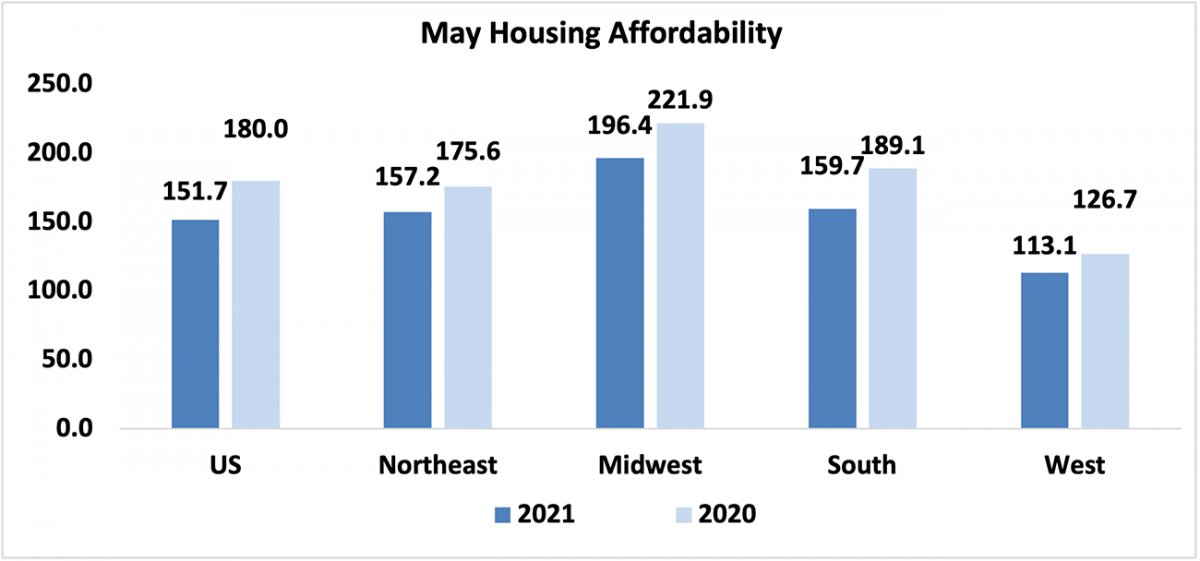Housing Affordability Falls in May as Home Prices Rise Faster than Income
Friday Jul 09th, 2021
At the national level, housing affordability declined in May compared to a year ago according to NAR's Housing Affordability Index, as the median family incomes rose modestly by 1.2% while the monthly mortgage payment increased 20%. The effective 30-year fixed mortgage rate1 was 3.01% this May compared to 3.29% one year ago, but the median existing-home sales price rose 24.4% from one year ago.
Compared to the prior month, affordability also worsened as the monthly mortgage payment rose by 1.7% while the median family income declined by 1.0%.
As of May 2021, the national and regional indices were all above 100, meaning that a family with the median income had more than the income required to afford a median-priced home. The income required to afford a mortgage, or the qualifying income, is the income needed so that mortgage payments account for 25% of family income.2 The most affordable region was the Midwest, with an index value of 196.4 (median family income of $86,440 with a qualifying income of $44,016). The least affordable region remained the West, where the index was 113.1 (median family income of $94,183 and a qualifying income of $83,280). The South was the second most affordable region with an index of 159.7 (median family income of $80,019 and a qualifying income of $50,112) The Northeast was the second most unaffordable region with an index of 157.2 (median family income of $99,087 and a qualifying income of $63,024).
Housing affordability3 declined from a year ago in of the four regions. The South had the biggest decline of 15.5%. The Midwest region experienced a weakening in price growth compared to a year ago of 11.5%, followed by the West with a dip of 10.7%. The Northeast had the smallest decrease of 10.5%.
Affordability is down in all four regions from last month. The South had the biggest decline of 3.9% followed by the Midwest which fell 3.1%. The West region fell modestly 0.5% followed the Northeast region with the smallest decrease of 0.4%.
Nationally, mortgage rates were down 28 basis points from one year ago (one percentage point equals 100 basis points).
Compared to one year ago, the monthly mortgage payment rose to $1,204 from $1,003, an increase of 20.0%, The annual mortgage payment as a percentage of income inclined to 16.5% this May from 13.9% from a year ago due to higher home prices and a decline in median family incomes. Regionally, the West has the highest mortgage payment to income share at 22.1 % of income. Home prices in the West have reached an all-time high of $513,700. The Northeast had the second highest share at 15.9% followed by the South with their share at 15.7%. The Midwest had the lowest mortgage payment as a percentage of income at 12.7%. Mortgage payments are not burdensome if they are no more than 25% of income.4
With an abundance of buyers looking at slowly increasing inventory, demand is forcing home prices to continue to rise. Mortgage rates have been declining for the last three months and are still historically low.
This week, The Mortgage Bankers Association reported a decline in mortgage applications from a week ago.5 Mortgage credit availability was up 1.4 in May which means credit was loosening.
What does housing affordability look like in your market? View the full data release.
The Housing Affordability Index calculation assumes a 20% down payment and a 25% qualifying ratio (principal and interest payment to income). See further details on the methodology and assumptions behind the calculation.
1 Starting in May 2019, FHFA discontinued the release of several mortgage rates and only published an adjustable-rate mortgage called PMMS+ based on Freddie Mac Primary Mortgage Market Survey. With these changes, NAR discontinued the release of the HAI Composite Index (based on 30-year fixed-rate and ARM) and starting in May 2019 only releases the HAI based on a 30-year mortgage. NAR calculates the 30-year effective fixed rate based on Freddie Mac's 30-year fixed mortgage contract rate, 30-year fixed mortgage points and fees, and a median loan value based on the NAR median price and a 20 percent down payment.
2 The 25% mortgage payment to income share takes into consideration that a homeowner has other expenses such as property insurance, taxes, utilities, and maintenance so that total housing expenses are no more than 30% of income. Housing costs are not burdensome if they account for no more than 30% of income.
3 A Home Affordability Index (HAI) value of 100 means that a family with the median income has exactly enough income to qualify for a mortgage on a median-priced home. An index of 120 signifies that a family earning the median income has 20 percent more than the level of income needed to pay the mortgage on a median-priced home, assuming a 20 percent down payment so that the monthly payment and interest will not exceed 25 percent of this level of income (qualifying income).
4 Total housing costs that include the mortgage payment, property taxes, maintenance, insurance, utilities are not considered burdensome of they account for any more than 30% of income.
5 The Mortgage Bankers Association (MBA) Mortgage Credit Availability Index analyzes data from Ellie Mae's AllRegs® Market Clarity® business information tool. A decline in the MCAI indicates that lending standards are tightening, while increases in the index are indicative of loosening credit. The MCAI is calculated using several factors related to borrower eligibility (credit score, loan type, loan-to-value ratio, etc.) for over 95 lenders/investors.







Post a comment